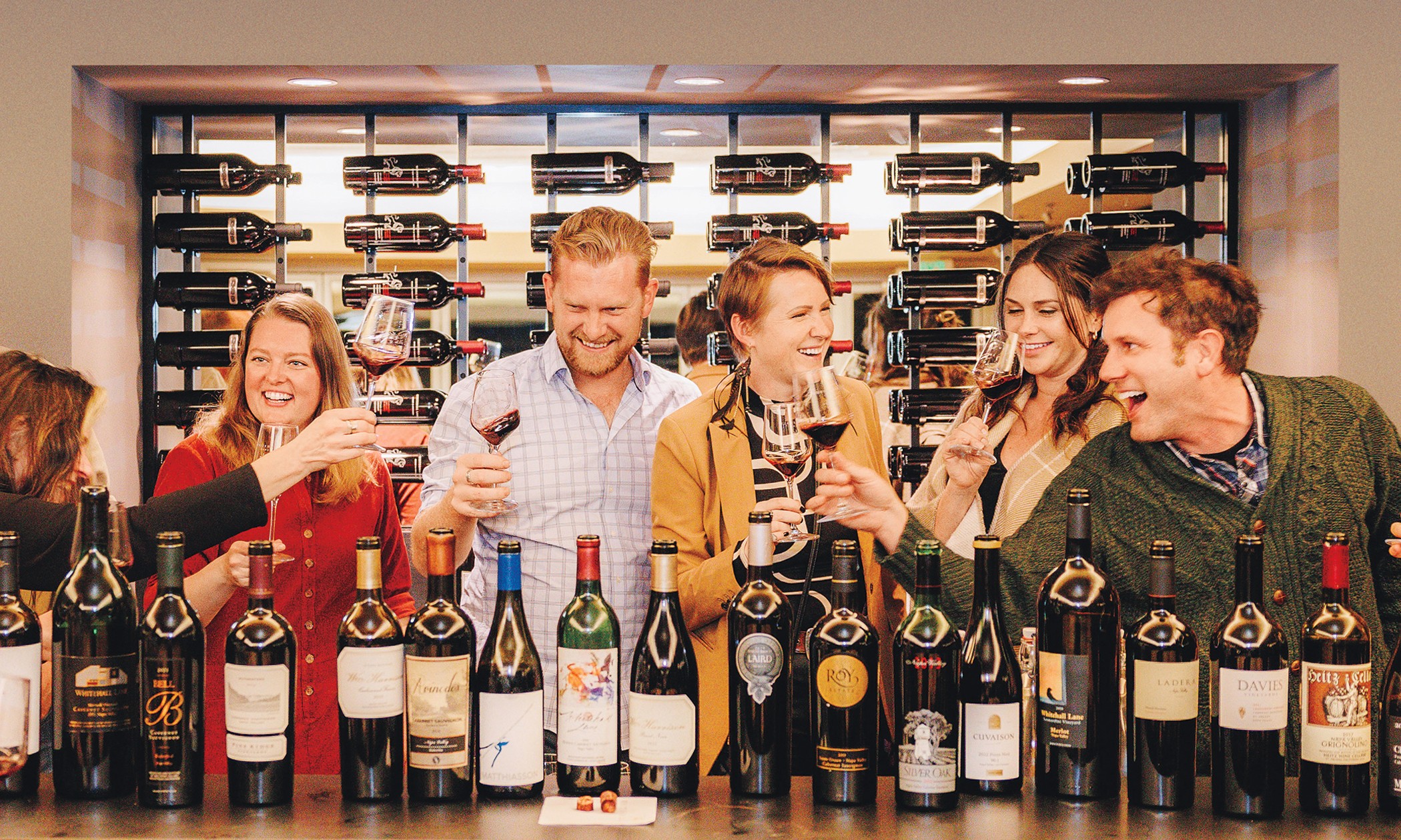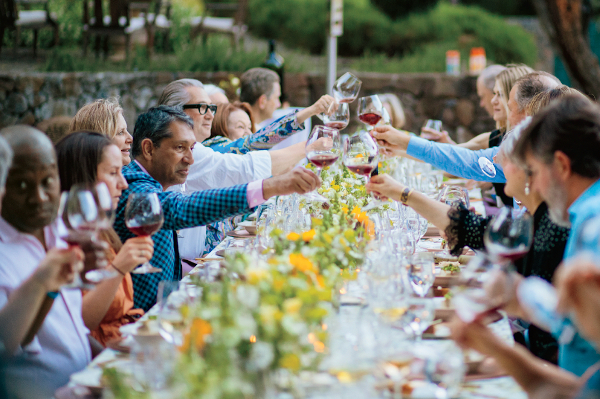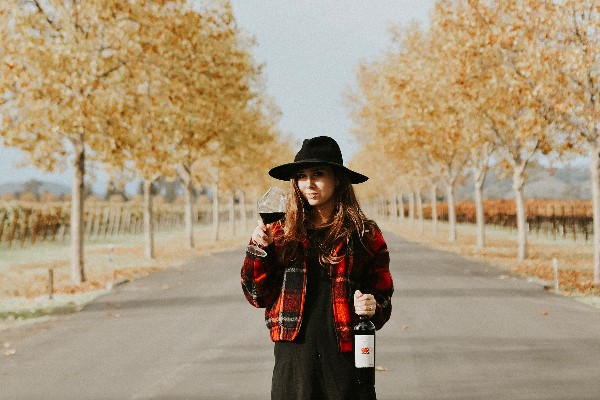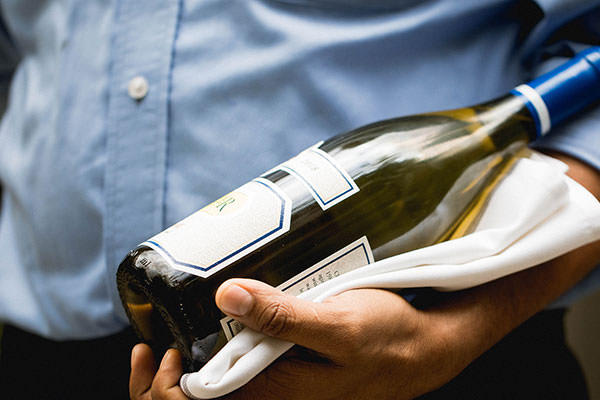I left my first professional wine tasting in tears. I remember the people who sat around the table, shoulders hunched over their wine glasses, noses like beaks taking sniffs, cawing everything from green apples to white flowers at each other. And then it was my turn to speak. Like a baby bird, I flung myself into wine jargon—it smells like cake, I said, to a clamor of giggles. I spilled wine as I swirled, didn’t know how to use a spit bucket and felt totally tipsy and out of my league.
Wine can be intimidating, I get it. Luckily, things are changing.
Wine tastings have long been a caricature of rules and proper etiquette that many people are afraid to break. Tasting groups countrywide are, however, breaking down this intimidation of wine and inviting more people to the table. They’re doing this by simply making the whole process more fun.
THEMED WINE TASTING GROUPS: WHERE SHARING IS CARING
Michael Patland of Patland Estate Vineyards in Napa began his private tasting group in 2021 with a monthly wine night. On the first Wednesday of the month, everyone in the group brings a wine that fits a theme, which rotates between region, grape variety and wild-card topics. Regional wine nights might focus on French or California wines, Cabernet Franc could be a varietal focus and past examples of wild-card themes have included an izakaya sake night and “green wines” for St. Patrick’s Day.
“In October, you can bring whatever wine you want as long as you dress in a costume inspired by a wine label,” says Patland, a CMS-certified sommelier. For newbie attendee Madyson Palmer, October was her very first wine night.
“I brought Decoy wine, which has a duck on the label, so I went as a duck hunter,” says Palmer.
The group, usually more than 30 people, is led by husband and wife RJ and Aiste Ballou, who offer approachable education on the theme. In December, the theme was Gateway into Napa, where members brought a bottle that immersed them in Napa Valley wine.
“Everyone is looking for something a little different from wine night, but at the heart of it is community,” says Patland. Though the group is mostly industry professionals, they welcome non-trade people like Palmer, a certified barbecue judge and walk manager with the Alzheimer’s Association. She says she spends a lot of time picking out wine to bring to the tasting, seeing it as a major learning opportunity.
“It’s so fun. I get to taste wines I would never get the opportunity to,” says Palmer. “People in the group want to not only have fun but also dig deep with what they bring to the group. I have tasted wines from 2007, 1998 and even older.”
INVITING MANY CUISINES TO THE TABLE
Elsewhere in the country, Kelly Cornett, a wine consultant in Atlanta, organizes industry tasting groups at specialty Asian restaurants on Buford Highway—a 30-mile stretch of road in Atlanta known for its diverse Asian and Mexican dining. The restaurants tend to have a BYOB policy, which allows the tasting group to experiment with unique wine pairings.
“It’s a conversation starter and invites new people in,” says Cornett. “If you’ve never paired a wine with bibimbap, for example, you need to do that. I would have never put those two things on the table together. And now we’re enjoying the intriguing pairing.”
Cornett, who hosts the podcast A Cork in the Road, is also known to pair Atlanta’s famous fried and lemon pepper wet wings (with lemon pepper seasoning and Buffalo sauce) with sparkling wine at her events. For her, it’s about starting with a local delicacy people know and adding wine to the fold.
“I want to create a moment through the excitement of something you’ve never had before. It’s memorable,” says Cornett. “If they come for the wings, they might discover the wine. That’s accessibility—you’re broadening the reach.”
Similarly, in San Francisco, Francesca Maniace, the director of programming at Flatiron Wines & Spirits, holds pop-up tastings called Bubb Club across the city. She works with local restaurants to pair grower Champagnes with breakfast tacos, Thai fried chicken, pizza and sandwiches. The tastings are ticketed and open to the public.
“I don’t have this preciousness about wine,” says Maniace. “I like when people can bring it down and be communal about it.”
Verve Wine in Chicago (with additional locations in New York City and San Francisco) holds an annual burgers and wine pairing tasting event, inviting people to sample Wagyu burgers and short rib fries with red and white wines by the glass. Every Sunday, the shop also offers a free tasting of two wines called Sunday Sippers. The wines range from new arrivals to classics and local producers.
Countrywide, countless wine shops, pop-ups and private tasting groups offer spaces to relax and enjoy wine in an unfussy way. Whether that’s enjoying rare collectibles paired with a jazz performance (the Dive Wine pop-up in Atlanta led by sommelier Tim Willard does just that) or a pasta-making class at a wine shop (Haley’s Wines in North Hollywood), the common denominator among these experiences is the same: building community.
THE RISE OF VIRTUAL WINE TASTINGS
It doesn’t have to be in person, either. Virtual tastings gained popularity in the pandemic and still bring together pools of people. The Ancient Wine Guys wine club offers bimonthly Zoom tastings on traditional wines from regions like Lebanon, Georgia and Turkey. Topics such as the legacy of Cleopatra, wine roots of Rome and sites and wines of the Panhellenic Games are discussed from the perspectives of history, literature, geography and archaeology.
Groups can also taste with a winemaker. Bouchaine Vineyards in Napa Valley offers virtual tastings with their president and winemaker, Chris Kajani. She covers beginner topics like how wine gets its color and what makes Napa Valley a leading wine region to more in-depth subjects like what drives differences in wine prices. Cain Vineyard & Winery in Napa’s Spring Mountain District hosts their own tasting group, led by winegrower and general manager Chris Howell. Offered four times a year and focusing on two or three wines per session, Howell explores subjects such as valley versus mountain, library wines, suggested food pairings and the impact of native yeasts.
SO, YOU WANNA START A TASTING GROUP?
If you’re considering starting a tasting group, Patland has advice from his monthly wine nights.
“First, decide what you want out of it. If the goal is education and tasting practice, take a more structured approach and know that someone has to take the reins and facilitate that,” says Patland. “If it’s community, then start small and pay attention to how people interact. Just because you are the common denominator in a group of people doesn’t mean they’re guaranteed to get along. Be thoughtful. Start small.”
Once a rhythm and objectives are established, grow the group slowly, meet people where they are in regard to wine knowledge and, well, have fun.
“At the end of the day, I see [the tasting group] as a guarantee of seeing all my friends once a month for dinner and [having] some kick-ass wine!”
As for me, I haven’t left another wine tasting group in tears again. I found my voice and my listening ear. Wine has a universal romanticism that draws so many of us to it. Sharing this beauty with like-minded people is what makes tasting groups so enjoyable. If you are welcoming a new member to your table, be sure to take them under your wing. Let them discover wide-eyed, the same way you did, how a wine that smells like cake is just as delicious as any.




